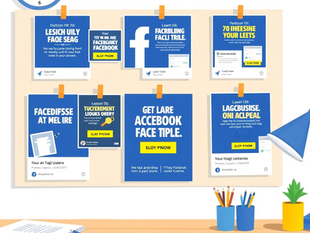
Mastering Facebook Audience Targeting: A Complete Guide
0
0
0

Ever wondered why some Facebook ads seem to hit the right audience every time while others miss the mark completely? The difference usually comes down to how well you target your audience. Facebook’s ad platform offers powerful targeting tools that can make or break your campaign success. Mastering Facebook audience targeting matters because it determines who sees your ad, how they respond, and how much it ultimately costs you to get a result. In this complete guide, you’ll learn the best practices, tools, and step-by-step strategies to effectively target audiences on Facebook—and improve your campaign ROI.
📑 Table of Contents
5. Sample Plan / Targeting Template
1. Highlights / Overview
Core AudiencesUse demographic, location, interest, and behavior filters to reach new prospects.
Custom AudiencesRe-target users based on website visits, email lists, or app activity.
Lookalike AudiencesFind new people who share traits with your best customers.
Detailed Targeting ExpansionLet Facebook auto-optimize reach beyond your manual selections.
Exclusion TargetingRefine results by excluding irrelevant or already-converted audiences.
A/B Testing Targeting VariablesTest different audience groups to find the highest converters.
Layering StrategyCombine multiple filters to create hyper-focused segments.
2. In-Depth Breakdown

Core Audience Targeting
Definition: Target users using Facebook’s filters—age, gender, location, interests, behaviors.
Why it matters: Helps build awareness among new potential customers.
Tips:
Combine interests with behaviors for higher intent.
Use local targeting for event-based or retail campaigns.
Custom Audiences
Definition: Create segments from people who already interacted with your brand.
Why it matters: Increases conversions through retargeting warm leads.
Tips:
Upload email lists or use Facebook Pixel to capture site visitors.
Retarget cart abandoners or video viewers.
Lookalike Audiences
Definition: Facebook identifies users similar to your existing customers.
Why it matters: Scales performance by targeting new, high-quality leads.
Tips:
Use a high-quality source audience (e.g., recent purchasers).
Test different size ranges (1%–5%) for broader vs. tighter matches.
Exclusion Targeting
Definition: Filter out audiences who’ve already converted or are not relevant.
Why it matters: Saves budget and avoids ad fatigue.
Tips:
Exclude past buyers in prospecting campaigns.
Exclude employees, competitors, or test users.
Detailed Targeting Expansion
Definition: Facebook dynamically expands your reach beyond your set filters.
Why it matters: Can improve results when your defined audience is too narrow.
Tips:
Enable this only after testing narrow vs. broad audiences.
Monitor results with breakdowns in Ads Manager.
3. Practical Tips & Tools
Tools to Use
Facebook Ads Manager – Central platform for building, managing, and analyzing ads.
Meta Pixel – Tracks user behavior on your site for retargeting.
Audience Insights – Analyze audience interests, behaviors, and demographics.
Meta Business Suite – Organizes assets across Facebook and Instagram.
Time/Money Hacks
Save audience templates for repeated campaigns.
Use A/B testing to compare audiences without duplicating campaigns.
Start with small budgets to validate audiences before scaling.
4. Implementation Guide

Log into Ads Manager and choose “Create Ad.”
Select your campaign objective (e.g., Conversions, Traffic).
Go to the Audience section in the ad set level.
Choose Custom, Lookalike, or Core Audience type.
Layer your filters (location, age, interest, behavior).
Use exclusions to refine who should not see the ad.
Save your audience for future use.
Launch your ad and monitor performance under Breakdown → "By Audience."
Common Pitfalls
Targeting too broadly without enough filters.
Over-segmenting audiences (too narrow = fewer results).
Not excluding converted users.
Forgetting to refresh Lookalike source data over time.
5. Sample Plan / Targeting Template
Example: E-Commerce Product Launch Campaign
Objective: ConversionsAudience Type: Lookalike + CustomLocation: U.S. OnlyCore Filters: Women, Ages 25–44, Interests in fitness + fashionCustom: Website visitors past 30 daysExclusions: Previous purchasersBudget: $300 over 7 days
Schedule:
Day 1–2: Run Custom Audience retargeting ad.
Day 3–5: Launch Lookalike based on buyers.
Day 6–7: Enable targeting expansion to scale.
Insider Tips:
Monitor Frequency to avoid burnout.
Use video in retargeting to re-engage viewers.
Adjust based on daily Cost Per Result.
6. FAQs
Q1: What is the best audience type for beginners?A1: Start with Core Audiences using interest + behavior filters.
Q2: Can I use multiple audience types in one ad set?A2: No, only one audience type per ad set. Use separate sets to compare.
Q3: How often should I update Lookalike sources?A3: Every 30–60 days to keep data fresh and relevant.
Q4: Can I combine Lookalike with interest targeting?A4: No, Facebook treats them separately. Create separate sets for clean tests.
Q5: How do I retarget website visitors?A5: Use Meta Pixel to build a custom audience from recent site traffic.
7. Conclusion
Targeting the right audience is the foundation of every successful Facebook ad campaign. Whether you're retargeting warm leads or scaling through Lookalike audiences, your targeting strategy directly impacts ROI. By mastering Facebook audience targeting, you can reduce ad waste, increase conversions, and build deeper brand connections. Start testing your targeting today and watch your results soar. Try this targeting plan and let us know how it performs!












